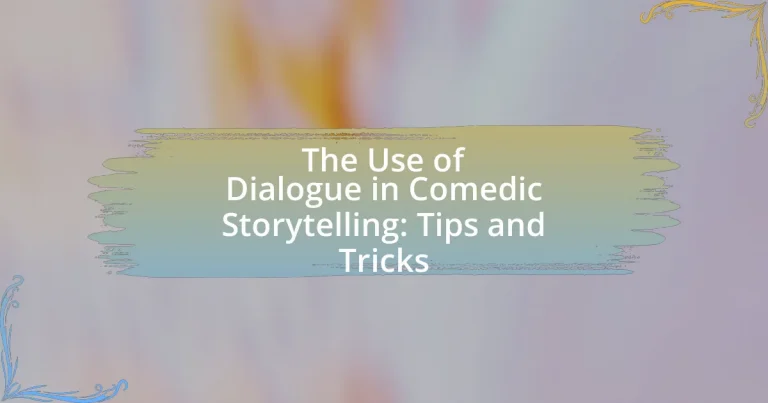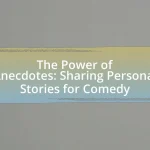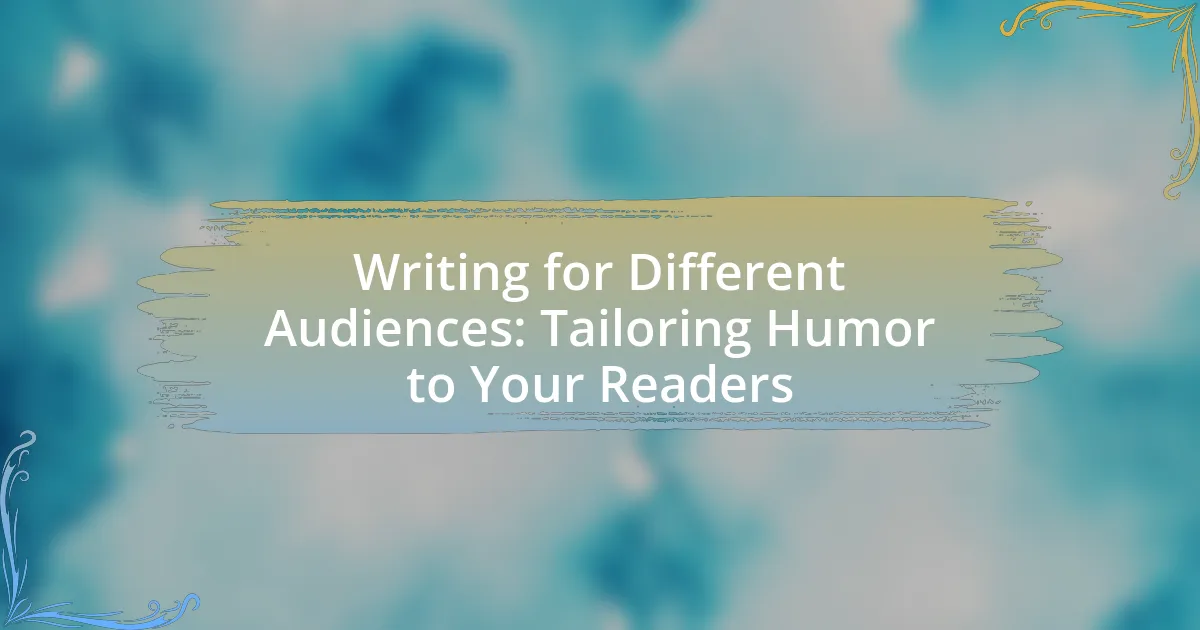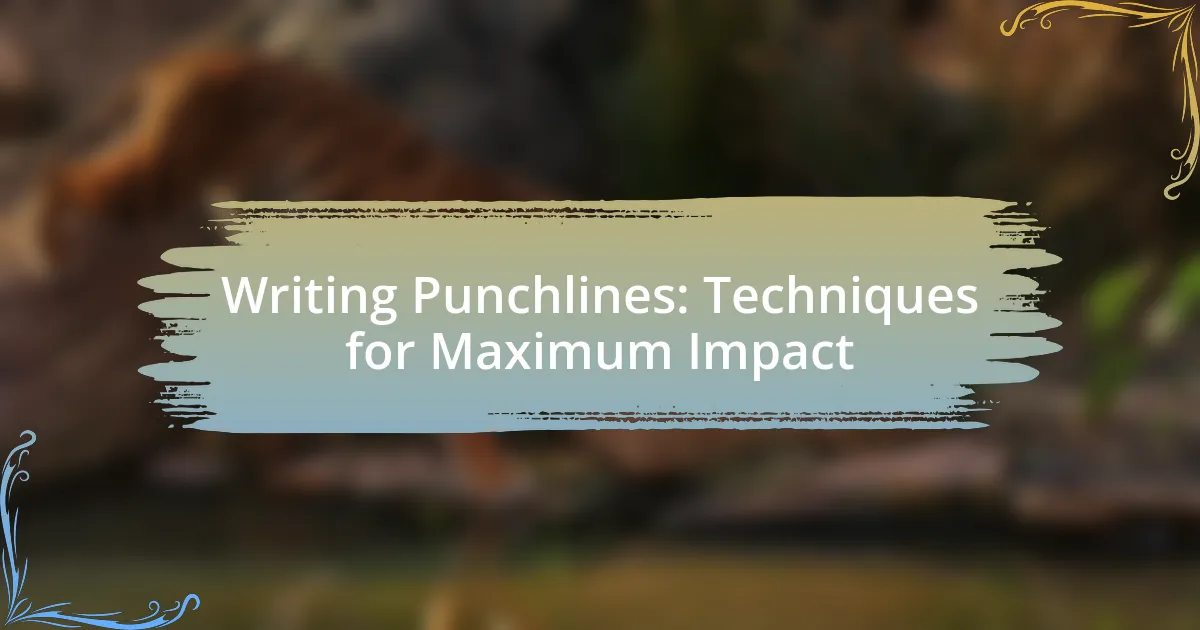The article focuses on the role of dialogue in comedic storytelling, emphasizing its importance in delivering humor, developing character relationships, and advancing the plot. It explores techniques that enhance comedic elements, such as timing, wordplay, and character voice, while also discussing how dialogue reveals personality traits and establishes relationships between characters. Additionally, the article outlines practical tips for writing effective comedic dialogue, including the integration of visual gags and the significance of pacing and rhythm. Resources for further study and practice in comedic dialogue are also provided, making it a comprehensive guide for writers looking to refine their skills in this area.
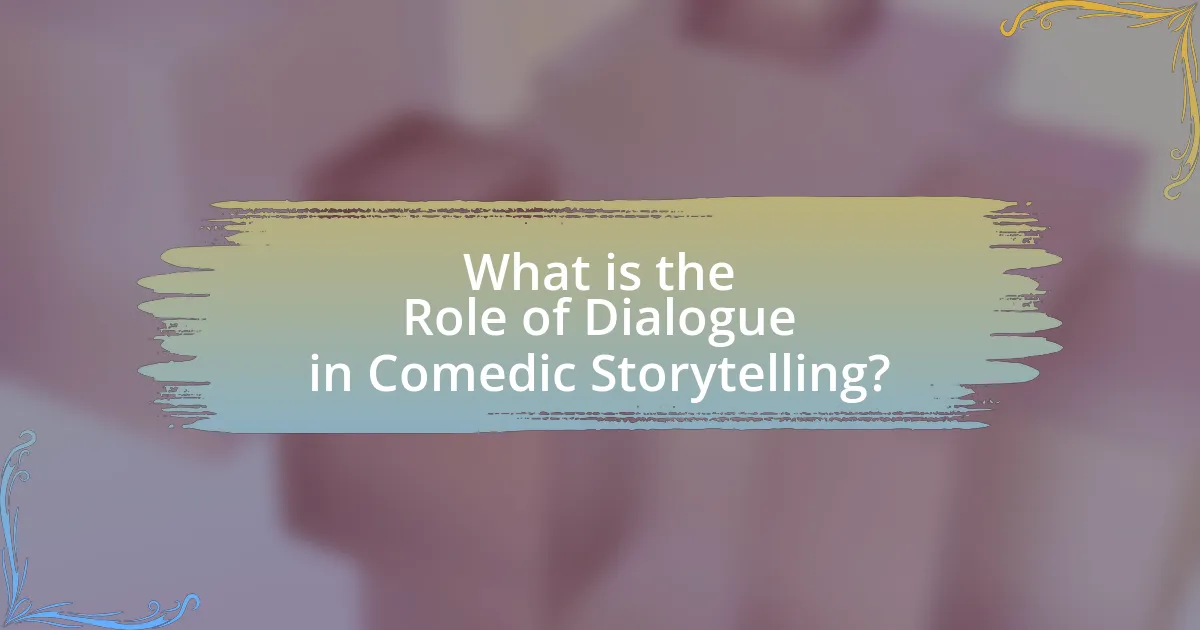
What is the Role of Dialogue in Comedic Storytelling?
Dialogue serves as a crucial mechanism in comedic storytelling by delivering humor, developing character relationships, and advancing the plot. It allows characters to express wit and sarcasm, creating comedic tension and timing that engages the audience. For instance, the use of puns, misunderstandings, and rapid exchanges can enhance comedic effect, as seen in classic sitcoms like “Friends,” where dialogue drives both humor and character dynamics. Research indicates that effective comedic dialogue often relies on timing and rhythm, which can significantly influence audience laughter and engagement.
How does dialogue enhance comedic elements in storytelling?
Dialogue enhances comedic elements in storytelling by creating timing, character dynamics, and situational irony. Effective dialogue allows for punchlines to land with precision, as the rhythm and pacing can amplify humor. For instance, in sitcoms, rapid exchanges between characters often lead to heightened comedic tension, making the audience more receptive to jokes. Additionally, dialogue reveals character traits and relationships, which can lead to humorous misunderstandings or conflicts, as seen in classic comedies like “Friends.” The use of wordplay, puns, and absurdity in dialogue further contributes to comedic effect, as evidenced by the works of playwrights like Oscar Wilde, who skillfully employed witty repartee to elicit laughter.
What techniques make dialogue funnier in a narrative?
Techniques that make dialogue funnier in a narrative include wordplay, timing, and character voice. Wordplay, such as puns or double entendres, creates humor through clever language manipulation. Timing, particularly the use of pauses or rapid exchanges, enhances comedic effect by building anticipation or surprise. Character voice, which reflects distinct personalities and quirks, adds authenticity and relatability, making the humor more impactful. Research indicates that humor in dialogue often relies on the incongruity theory, where unexpected twists in conversation elicit laughter, demonstrating that these techniques effectively engage audiences.
How does timing affect the comedic impact of dialogue?
Timing significantly affects the comedic impact of dialogue by determining when a punchline or humorous remark is delivered. Effective timing can enhance the surprise element of a joke, making it more impactful; for instance, a well-placed pause before a punchline can build anticipation and amplify laughter. Research in comedy, such as the work by John Morreall in “Taking Laughter Seriously,” indicates that timing is crucial for maximizing humor, as it influences the audience’s emotional response and cognitive processing of the joke. Thus, precise timing in dialogue not only enhances the delivery but also ensures that the humor resonates with the audience.
Why is dialogue important for character development in comedy?
Dialogue is crucial for character development in comedy because it reveals personality traits, motivations, and relationships through humor and wit. In comedic storytelling, characters often express themselves in exaggerated or absurd ways, allowing their unique voices to shine through. This not only enhances the comedic effect but also helps the audience understand the characters on a deeper level. For instance, a character’s use of sarcasm or puns can indicate intelligence or insecurity, while their timing and delivery can showcase their confidence or awkwardness. Such nuances in dialogue contribute to the audience’s connection with the characters, making them more relatable and memorable.
How can dialogue reveal a character’s personality in a humorous way?
Dialogue can reveal a character’s personality in a humorous way by showcasing their unique speech patterns, word choices, and reactions to situations. For instance, a character who uses sarcasm frequently may indicate a witty or cynical personality, while someone who employs puns or playful language might suggest a lighthearted and jovial nature. This is evident in comedic works like “The Office,” where characters like Michael Scott use awkward humor and misunderstandings to highlight their lack of social awareness, thus defining their personalities through dialogue. Such interactions not only entertain but also provide insight into the character’s motivations and traits, making humor an effective tool for character development.
What role does dialogue play in establishing relationships between characters?
Dialogue serves as a crucial mechanism for establishing relationships between characters by revealing their thoughts, emotions, and dynamics. Through dialogue, characters express their intentions, conflicts, and connections, allowing audiences to understand the nature of their relationships. For instance, in comedic storytelling, witty exchanges and banter can highlight camaraderie or tension, effectively showcasing the characters’ rapport or rivalry. This interaction not only develops character depth but also engages the audience, making the relationships more relatable and impactful.

What are the Key Techniques for Writing Comedic Dialogue?
Key techniques for writing comedic dialogue include timing, wordplay, and character voice. Timing involves delivering lines at the right moment to maximize humor, often using pauses or quick exchanges to create rhythm. Wordplay, such as puns and double entendres, adds cleverness and wit, engaging the audience through linguistic creativity. Character voice ensures that each character’s dialogue reflects their unique personality, making interactions feel authentic and relatable. These techniques are supported by the success of comedic works like “The Office,” where timing and character-driven humor are pivotal to its appeal.
How can writers create witty and engaging dialogue?
Writers can create witty and engaging dialogue by incorporating humor, subtext, and character-specific language. Humor can be achieved through wordplay, puns, and unexpected twists in conversation, which keeps the audience entertained. Subtext allows characters to convey deeper meanings and emotions without explicitly stating them, adding layers to the dialogue. Additionally, using language that reflects each character’s unique personality and background makes the dialogue more authentic and relatable. Research indicates that effective dialogue often mirrors real-life conversations, where timing and delivery play crucial roles in humor (Katz, 2015, “The Art of Dialogue”). This combination of techniques ensures that dialogue remains lively and engaging for readers.
What are the best practices for using puns and wordplay in dialogue?
The best practices for using puns and wordplay in dialogue include ensuring clarity, maintaining relevance to the context, and timing the delivery effectively. Clarity is crucial; puns should be easily understood to avoid confusion, as seen in successful comedic works where wordplay enhances rather than detracts from the narrative. Relevance ensures that the pun aligns with the characters and situation, making it feel organic; for instance, in “The Office,” character-specific humor often utilizes puns that reflect their personalities. Effective timing, such as delivering a pun at a moment of tension or surprise, can amplify its comedic impact, as demonstrated in stand-up routines where punchlines are strategically placed for maximum effect.
How can exaggeration be effectively used in comedic dialogue?
Exaggeration can be effectively used in comedic dialogue by amplifying characteristics, situations, or emotions to create humor. This technique relies on the audience’s recognition of the absurdity in the exaggerated elements, which enhances comedic impact. For instance, a character might describe a minor inconvenience, like losing a sock, as a catastrophic event, thereby highlighting the humor in their overreaction. Research indicates that exaggeration in humor can trigger laughter by subverting expectations, as seen in studies by psychologists like Peter McGraw and Caleb Warren, who explored the benign violation theory, suggesting that humor arises when something is perceived as both a violation and benign.
What are common pitfalls to avoid when writing comedic dialogue?
Common pitfalls to avoid when writing comedic dialogue include relying on clichés, over-explaining jokes, and neglecting character voice. Relying on clichés can make the dialogue feel unoriginal and predictable, which diminishes comedic impact. Over-explaining jokes often leads to a loss of humor, as the punchline should be delivered with brevity and timing. Neglecting character voice results in dialogue that feels inauthentic, as each character should have a distinct way of speaking that reflects their personality and background. These pitfalls can undermine the effectiveness of comedic dialogue and reduce audience engagement.
How can clichés undermine the effectiveness of comedic dialogue?
Clichés undermine the effectiveness of comedic dialogue by making jokes predictable and unoriginal. When comedians rely on overused phrases or scenarios, they fail to surprise the audience, which is essential for humor. Research indicates that humor often relies on incongruity and surprise; therefore, predictable elements diminish the comedic impact. For example, a study published in the Journal of Humor Research highlights that audiences respond more positively to novel and unexpected comedic elements, reinforcing the idea that clichés can detract from the overall effectiveness of humor in dialogue.
What are the risks of overusing sarcasm in dialogue?
Overusing sarcasm in dialogue can lead to misunderstandings and damage relationships. When sarcasm is frequent, it may cause listeners to misinterpret the speaker’s true intentions, leading to confusion or offense. Research indicates that excessive sarcasm can create a barrier to effective communication, as it often relies on tone and context that may not be clear to all participants. Additionally, a study published in the Journal of Language and Social Psychology found that individuals who frequently use sarcasm may be perceived as insincere or untrustworthy, which can hinder social connections and collaboration.

How can Dialogue be Used to Enhance Comedic Timing?
Dialogue can enhance comedic timing by utilizing pacing, word choice, and delivery to create rhythm and surprise. Effective comedic dialogue often employs pauses and timing to build anticipation, allowing punchlines to land more effectively. For instance, a well-placed pause before a punchline can amplify its impact, as seen in stand-up comedy routines where timing is crucial for eliciting laughter. Additionally, the use of unexpected word choices or absurdity in dialogue can catch the audience off guard, further enhancing the comedic effect. Research indicates that timing in comedy is essential; a study published in the journal “Psychological Science” found that the timing of jokes significantly affects audience laughter, demonstrating the importance of dialogue in achieving comedic success.
What techniques can improve the pacing of comedic dialogue?
Techniques that can improve the pacing of comedic dialogue include timing, rhythm, and strategic pauses. Timing involves delivering lines at the right moment to maximize comedic effect, as seen in classic sitcoms where punchlines are often followed by brief pauses to allow laughter. Rhythm refers to the flow of dialogue, where varying sentence lengths can create a dynamic exchange that keeps the audience engaged; for example, quick back-and-forth exchanges can heighten tension and humor. Strategic pauses allow for comedic beats, giving the audience time to react and enhancing the impact of the joke. These techniques are supported by studies in comedic timing, such as those by researchers like John Cleese, who emphasize the importance of timing in delivering humor effectively.
How does the rhythm of dialogue contribute to comedic timing?
The rhythm of dialogue significantly contributes to comedic timing by controlling the pace and flow of jokes, enhancing their impact. A well-timed pause can create anticipation, allowing the punchline to land more effectively, while rapid exchanges can generate a sense of chaos that amplifies humor. Research indicates that comedic timing relies on the precise manipulation of rhythm, where studies show that timing variations can influence audience laughter rates, with optimal pauses leading to increased comedic effect.
What role does silence play in enhancing comedic moments?
Silence plays a crucial role in enhancing comedic moments by creating tension and anticipation, which can amplify the impact of subsequent dialogue or actions. When a character pauses or remains silent, it allows the audience to absorb the situation, often leading to heightened expectations for what will happen next. This technique is frequently employed in comedy, as evidenced by the use of pauses in stand-up routines or sitcoms, where the timing of silence can lead to laughter by subverting audience expectations. For example, in the television show “The Office,” moments of awkward silence often precede humorous revelations, illustrating how silence can serve as a powerful comedic tool.
How can writers balance dialogue with physical comedy?
Writers can balance dialogue with physical comedy by ensuring that the dialogue complements the physical actions rather than overshadowing them. This can be achieved by using concise, punchy lines that enhance the comedic timing of physical gags. For instance, in classic comedies, characters often deliver witty one-liners just before or after a slapstick moment, creating a rhythm that keeps the audience engaged. Research in comedic timing indicates that the interplay between verbal and non-verbal humor can amplify the comedic effect, as seen in works by authors like Charlie Chaplin and the Marx Brothers, who expertly combined dialogue with visual humor to create memorable comedic scenes.
What are effective ways to integrate dialogue with visual gags?
Effective ways to integrate dialogue with visual gags include timing the dialogue to coincide with the visual action, using dialogue to set up or react to the visual gag, and ensuring that the dialogue enhances the humor of the visual element. For instance, a character might deliver a punchline just as a visual gag occurs, creating a comedic payoff that combines both elements. Research in comedic timing shows that synchronizing verbal and visual humor can significantly enhance audience laughter, as evidenced by studies indicating that well-timed jokes paired with visual cues increase comedic effectiveness.
How can dialogue complement physical actions for comedic effect?
Dialogue can complement physical actions for comedic effect by enhancing the absurdity or irony of the situation. When characters deliver witty or unexpected lines while engaging in exaggerated physical movements, the contrast amplifies the humor. For example, in classic slapstick comedy, a character might trip while confidently proclaiming their expertise, creating a humorous dissonance between their words and actions. This technique is supported by the principle of incongruity in humor theory, which suggests that humor arises when there is a mismatch between expectations and reality.
What are Practical Tips for Writing Effective Comedic Dialogue?
To write effective comedic dialogue, focus on timing, character voice, and subverting expectations. Timing is crucial; delivering punchlines at the right moment enhances humor, as seen in sitcoms where pauses amplify comedic effect. Character voice should be distinct and consistent, allowing each character’s personality to shine through their dialogue, which is evident in shows like “The Office,” where unique voices contribute to the humor. Subverting expectations involves setting up a scenario that leads the audience to anticipate a certain outcome, only to deliver an unexpected twist, a technique frequently used in stand-up comedy. These elements combined create engaging and humorous dialogue that resonates with audiences.
How can writers practice and refine their comedic dialogue skills?
Writers can practice and refine their comedic dialogue skills by engaging in regular writing exercises focused on humor, analyzing successful comedic works, and participating in workshops or feedback groups. Regularly writing short comedic scenes or dialogues helps develop timing and wit, while studying scripts from successful comedies, such as “The Office” or “Parks and Recreation,” provides insight into effective comedic structures and character interactions. Additionally, joining workshops or groups allows writers to receive constructive feedback, which is essential for honing their skills and understanding audience reactions.
What resources are available for studying comedic dialogue in storytelling?
Resources available for studying comedic dialogue in storytelling include books, online courses, and academic journals. Notable books such as “The Comic Toolbox” by John Vorhaus and “Writing Comedy” by John Kachuba provide foundational techniques and insights into crafting humorous dialogue. Online platforms like MasterClass offer courses from established comedians, such as Steve Martin, focusing on the nuances of comedic writing. Additionally, academic journals like “Comedy Studies” publish research articles that analyze comedic dialogue in various contexts, providing empirical evidence and theoretical frameworks for understanding humor in storytelling. These resources collectively enhance the study of comedic dialogue by offering practical guidance and scholarly analysis.
